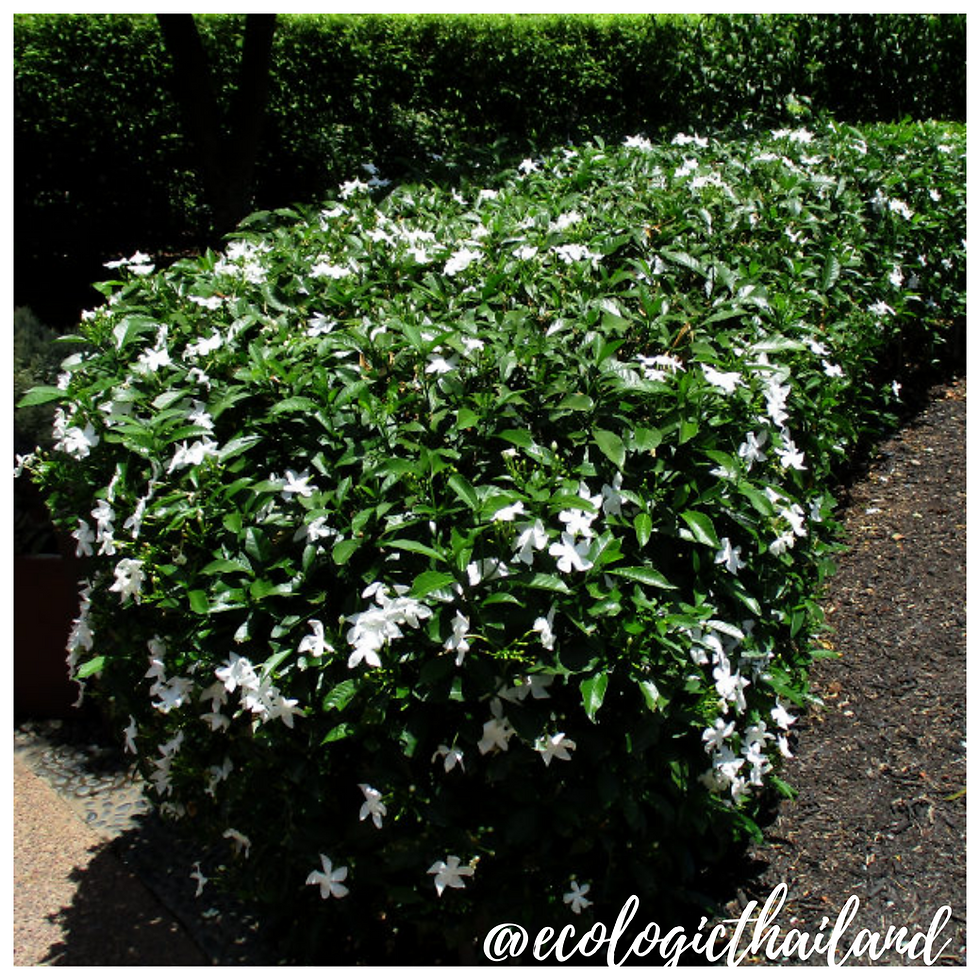Ming Aralia
- Eco-Logic Resort
- Mar 7, 2021
- 3 min read
Updated: May 31, 2021
lep khrut | เล็บครุฑ | Polyscias fruticosa'
Family: Araliaceae | Genus: Polyscias

The Ming Aralia can be found around the restaurant area of the Food Forest Kitchen.
Polyscias fruticosa, commonly called Ming aralia or Chinese Aralia, is an evergreen shrub that is native to tropical areas. It is is a perennial plant and an evergreen shrub. The plant grows fairly slowly but can reach up to 2.5 to 5 meters in height. The leaves are of a dark green pigment, glossy in texture, and are tripinnate and appear divided. Individual leaves vary from narrowly ovate to lanceolate and are about 10 centimeter long.
Ming aralia is a slow-growing, evergreen shrub with spreading branches, eventually reaching a height of around 2.5 to 5 meter. The plant provides edible leaves and also has medicinal uses. It is cultivated as an ornamental and hedge plant, as well as for culinary and medicinal use
The leaves of the evergreen Ming Aralia can be harvested the whole year.

THE SHRUB
Ming aralia is a slow-growing, evergreen shrub with spreading branches, eventually reaching a height of around 2.5 to 5 meter. The plant provides edible leaves and also has medicinal uses. It is cultivated as an ornamental and hedge plant, as well as for culinary and medicinal use

THE LEAVES
The leaves are of a dark green pigment, glossy in texture, and are tripinnate and appear divided. Individual leaves vary from narrowly ovate to lanceolate and are about 10 centimeter long.
The leaves are edible and also have medicinal use.

THE FLOWERS
Pale yellow to white flowers in free-branching inflorescences (to 15 centimeter long) bloom in summer (December - March). Fruit is a drupe.
The Ming Aralia rarely flowers or fruit.
THE FRUIT

Fruit is a drupe, flattened laterally, measuring 4 - 5 millimeter long and 4.5 - 6 millimeter wide.
The Ming Aralia rarely flowers or fruit.
CULINARY USES
In Thailand, Ming Aralia is called lep khrut (lit. "Garuda claws"). It can be eaten raw together with a spicy dip, or it can be boiled in curries
Young leaves and shoots can be eaten cooked[. Steamed and eaten as greens or added to soups etc. as a flavoring. They have an aromatic flavor, reminiscent of parsley.
All parts of those plants including stems, can be used dried or fresh to make a bitter, revitalizing and stimulating tea.
TRADITIONAL MEDICINAL USE
NOTE: please take advice from a doctor if you are planning to use herbal medicine.
Ming Aralia has been used for centuries in traditional medicine, where it is seen as being analgesic, febrifuge and diuretic.
Tough old roots, bark, stems and trunk are usually used dried and sliced to make decoctions, but it is also taken in form of powder. Tinctures can be made from any part of the plants but it is rarely used. All plant parts of the plant are bitter, spicy and fragrant, and it's actions are stimulating, adaptogenic, nerves calming, pain relieving, anti-inflammatory, diuretic, digestive, detoxifying, antibacterial, antifungal, antiseptic, febrifuge, antidiabetic, antiulcer, astringent, cardiostatic, and it stimulate blood circulation, but while the leaves are rather refreshing-cooling, the roots have worming and sudoriphic effect.
The root has an agreeable and strongly aromatic smell, it tastes like parsley, and is used as a diuretic. In Vietnam the roots are considered to be Ginseng substitute.
INTO THE WILD: a down to earth experience

For guests and visitors to Paksong we organize weekly tours "The Edible Forest" and Foraging weekends: Into the Wild. We work with local guides to take you in the jungle of Paksong. After foraging, we will cook a meal with the ingredients, using bamboo together with you!
Come and join and learn about the abundance of food that nature gives us!
INTO THE WILD!


















Comments